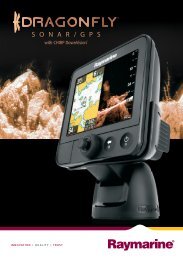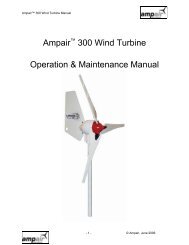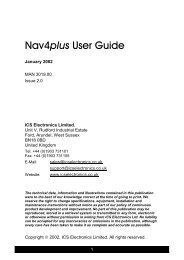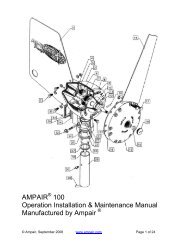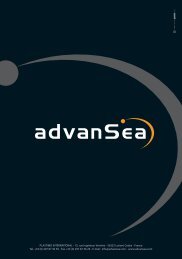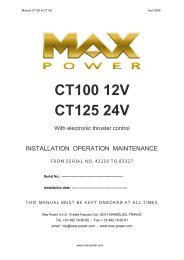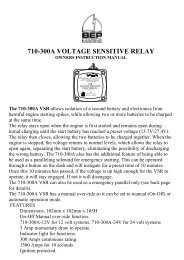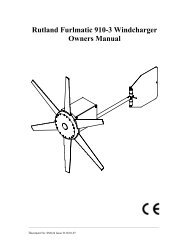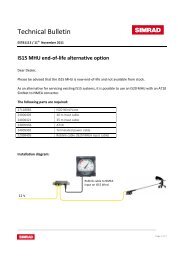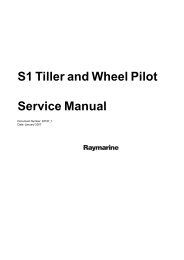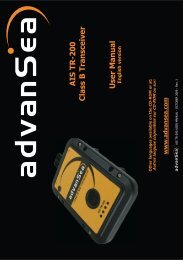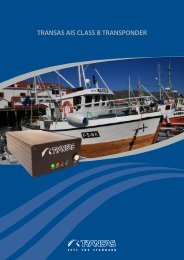User manual - JG Technologies
User manual - JG Technologies
User manual - JG Technologies
You also want an ePaper? Increase the reach of your titles
YUMPU automatically turns print PDFs into web optimized ePapers that Google loves.
1. Select the guard zone.<br />
The guard zone context menu is displayed.<br />
2. Select Adjust Zone.<br />
The Adjust guard zone menu is displayed.<br />
3. Select Zone shape to switch between Sector or Circle.<br />
4. Select Adjust Outer.<br />
i. Select the location on screen you wish the outer guard zone<br />
to be placed.<br />
5. Select Adjust Inner.<br />
i. Select the location on screen you wish the inner guard zone<br />
to be placed.<br />
6. Select Adjust Width.<br />
i. Select the location on screen you wish the guard zone width<br />
to be set to.<br />
7. Select Adjust Bearing.<br />
i. Select the location on screen you wish the guard zone<br />
bearing to be set to.<br />
Note: Guard zone width and bearing can only be adjusted when<br />
the Zone Shape is set to Sector.<br />
Adjusting guard zone sensitivity<br />
You can adjust the threshold at which the alarm is triggered by a<br />
target entering the guard zone.<br />
1. Select Menu.<br />
2. Select Track Targets.<br />
3. Select Guard Zone Set-up.<br />
4. Select Sensitivity.<br />
5. Using the Rotary Control adjust the threshold to the required<br />
percentage.<br />
6. Press Ok to save the changes.<br />
The guard zone sensitivity setting can also be accessed from the<br />
Alarms menu: homescreen > Set-up > Alarms > Guard Zone<br />
> Sensitivity.<br />
MARPA overview<br />
MARPA is used for target tracking and risk analysis in the radar<br />
application.<br />
With an accurate heading sensor connected to your multifunction<br />
display, you can use the Mini Automatic Radar Plotting Aid (MARPA)<br />
functions for target tracking and risk analysis. MARPA improves<br />
collision avoidance by calculating information for tracked targets,<br />
and provides continuous, accurate, and rapid situation evaluation.<br />
The number of targets that you can track at any one time is<br />
dependent on the model of radar scanner that you are using.<br />
MARPA tracks acquired targets, and calculates the target’s speed<br />
and course.<br />
Each target tracked can be displayed with a graphic indicating the<br />
Closest Point of Approach (CPA), and Time to Closest Point of<br />
Approach (TCPA). The calculated target data can also be shown on<br />
your screen. Each target is continually assessed and an audible<br />
alarm is sounded if a target becomes dangerous, or is lost.<br />
For effective MARPA operation, your multifunction display must<br />
have accurate heading and speed data for your vessel. The better<br />
the quality of the heading and speed data, the better MARPA will<br />
perform. For the best heading data, a Raymarine SMART heading<br />
sensor or a gyro-stabilized autopilot is required.<br />
In True Motion mode, Speed Over Ground (SOG) and Course Over<br />
Ground (COG) information is required to show true target course<br />
and speed.<br />
In Relative Motion mode, heading and speed information is required.<br />
Item<br />
1 2 3 4<br />
Description<br />
1 Safe target<br />
2 Lost target<br />
3 Dangerous target<br />
4 Target being acquired<br />
Safety notices<br />
D12219-1<br />
MARPA can improve collision avoidance when used wisely. It is<br />
your responsibility to exercise common prudence and navigational<br />
judgement.<br />
There are conditions where acquiring a target may become difficult.<br />
These same conditions may be a factor in successfully tracking a<br />
target. Some of the conditions are:<br />
• The target echo is weak. The target is very close to land, buoys<br />
or other large targets.<br />
• The target or your own vessel is making rapid manoeuvres.<br />
• Choppy sea state conditions exist and the target is buried in<br />
excessive sea clutter or in deep swells.<br />
• Choppy sea state conditions exist yielding poor stability; own<br />
vessel’s heading data is very unstable.<br />
• Inadequate heading data.<br />
Symptoms of such conditions include:<br />
• target acquisition is difficult and the MARPA vectors are unstable;<br />
• the symbol wanders away from the target, locks-on to another<br />
target, or changes to a lost symbol target.<br />
In these circumstances, target acquisition and tracking may need to<br />
be re-initiated and in some cases might be impossible to maintain.<br />
Better quality heading data might improve performance in these<br />
circumstances.<br />
How a MARPA risk is assessed<br />
Each target is monitored to ascertain whether it will be within a<br />
certain distance from your vessel within a certain time. If so, the<br />
target is designated as dangerous, and an audible warning is<br />
sounded and a warning displayed. The target symbol changes to<br />
the dangerous target symbol and flashes to indicate that it is a<br />
dangerous target. Acknowledging the alarm will remove the warning.<br />
If a target is lost, either because the MARPA software has lost<br />
contact with it, or because it has moved out of range, an audible<br />
alarm is sounded and an on-screen warning appears. The on-screen<br />
symbol will change to the target lost symbol. Acknowledging the<br />
warning will silence the alarm and remove the on-screen warning<br />
and the target lost symbol.<br />
Effective range for MARPA targets<br />
MARPA target acquisition is only available at radar range scales of<br />
up to 12 nm, although tracking continues at all ranges.<br />
If you change to a smaller range scale, targets may be beyond the<br />
range of your radar scanner and will be lost. In such cases, an<br />
on-screen warning indicates that the target is off-screen.<br />
Using radar 141




